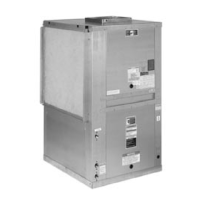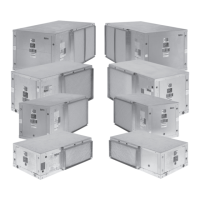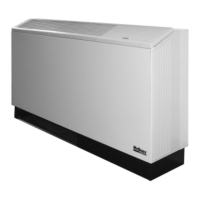Page 26 / IM 778
High
Normal
Low
Normal
Low
Normal
Charge
Undercharge System Low Low Low High Low Low Low Low Pressure
(Possible Leak)
Overcharge System High High High Normal High Normal High Pressure
Low Air Flow Heating High High High Low High Low High Pressure
Low Air Flow Cooling Low Low Low High High Low Low Temp
Low Water Flow Heating Low Low High Low High Low Temp
Low Water Flow Cooling High High High High Low Low High High Pressure
High Air Flow Heating Low Low Low Low High Low Low Low Temp
High Air Flow Cooling Low High Normal High Low Low Normal High Pressure
High Water Flow Heating Normal Low Normal High Normal Normal Low High Pressure
High Water Flow Cooling Low Low Low Low High Normal Low Low Temp
TXV Restricted High Low High High Low Low
Normal
Low
Low
Normal
Cooling Mode
Return Air
Reversing Valve
Conditioned Air
(Cooling)
Thermal
Expansion Valve
Co-Axial Heat
Exchanger
Blower
Coil –
Air to
Refrigerant
Heat
Exchanger
Water In
Water Out
Sensing
Bulb
and
Capillary
Tube
Compressor
Air Water Safety
Head Suction Compressor Super Temp (loops) Temp Lock
Symptom Pressure Pressure Amp Draw Heat Subcooling Differential Differential Out
Heating Mode
Return Air
Thermal
Expansion Valve
Co-Axial Heat
Exchanger
Reversing Valve
Conditioned Air
(Heating)
Blower
Water In
Water Out
Sensing
Bulb
and
Capillary
Tube
Compressor
Coil –
Air to
Refrigerant
Heat
Exchanger
Normal
Low
Troubleshooting Refrigeration Circuit
Cooling Refrigeration Cycle
When the wall thermostat is calling for COOLING, the
reversing valve directs the flow of the refrigerant, a hot gas,
leaving the compressor, to the water-to-refrigerant heat
exchanger. Here the heat is removed by the water and the
hot gas condenses to become a liquid. The liquid then
flows through a thermal expansion metering system to the
air-to-refrigerant heat exchanger coil. The liquid then evap-
orates becoming a gas, at the same time absorbing heat
and cooling the air passing over the surfaces of the coil.
The refrigerant then flows as a low pressure gas through
the reversing valve and back to the suction side of the
compressor to complete the cycle.
Heating Refrigeration Cycle
When the wall thermostat is calling for HEATING, the
reversing valve directs the flow of the refrigerant, a hot gas,
leaving the compressor, to the air-to-refrigerant heat
exchanger coil. Here the heat is removed by the air passing
over the surfaces of the coil and the hot gas condenses to
become a liquid. The liquid then flows through a capillary
thermal expansion metering system to the water-to-refriger-
ant heat exchanger. The liquid then evaporates becoming a
gas, at the same time absorbing heat and cooling the water.
The refrigerant then flows as a low pressure gas through the
reversing valve and back to the suction side of the com-
pressor to complete the cycle.

